Methods
Sample preparation: The PQ500 kit (Biognosys), containing 804 heavy labeled tryptic peptides for human plasma proteins, was used to develop a targeted peptide quantification assay. Assay development was performed with ~40 fmol on column peptide concentration. The peptides were then diluted into 500 ng digested human plasma across a concentration range of 2 amol/µL – 40 fmol/µL. 1 µL injections were performed.
Chromatography: A Waters ACQUITY UPLC M-class system was used in a trap-elute workflow. A Phenomenex Kinetex 2.6 µm XB-C18 100A, 150 x 0.3 mm LC column was used (P/N 00F-4496-AC) with a Phenomenex micro trap (P/N 05N-4252-AC). The column temperature was 30 ºC. Mobile phase A was water with 0.1% formic acid. Mobile phase B was acetonitrile with 0.1% formic acid. Samples were trapped at 10 µL/min for 3 min at 100% mobile phase A. A 20 minute linear gradient was used from 3-32% B using a flow rate of 5 µL/min.
Mass spectrometry: A SCIEX ZenoTOF 7600 system equipped with the OptiFlow Turbo V ion source was used with both the microflow probe and ESI calibration probe.2 Source conditions were as follows: CUR: 30 psi, GS1: 10 psi, GS2: 25 psi, IS: 5000 V, TEM: 200° C. MRMHR methods were constructed with TOF MS accumulation time of 100 msec. After optimization of charge states, fragment ions, and determination of the retention times for all peptides, they were analyzed in a single method using retention time scheduling. The final method was tested with both the Zeno trap on and the Zeno trap off, and the final concentration curve data was generated with the Zeno trap activated. A minimum accumulation time of 10 msec and a target cycle time of 1 sec was set. A retention time window of 40 sec was used.
Data processing: Method optimization data was processed in Skyline (daily version). Peptide information was then exported and imported into SCIEX OS software 2.0.1 in order to process the calibration curves in Analytics. Multiple fragment ions were summed for each peptide during computation of the calibration curves. Lower limit of detection (LLOD) was determined to be the peak detected above the blank (because of the very low noise with this approach, it is difficult to compute a signal/noise ratio). The lower limit of quantification (LLOQ) was determined using standard bioanalytical guidelines, requiring a %CV < 20% and an accuracy of ±20%.
Zeno MS/MS provides significant gains in peptide area
The Zeno trap technology on the ZenoTOF 7600 system provides significant gains in peptide fragment signal when activated, as it increases the duty cycle to ≥90% across the entire mass range in the orthogonal pulsing region of the instrument. This results in gains of 4-25 fold in MS/MS sensitivity.1 These duty cycle enhancements are accomplished by trapping ions in the Zeno trap region of the collision cell, then releasing them such that all ions arrive as a condensed packet at the same time in the TOF accelerator region.
An example of the gain in peptide signal when Zeno trap is activated is shown in Figure 1. Typically, when building targeted peptide assays, larger m/z fragment ions are used for specificity. With Zeno MS/MS, theoretical sensitivity gains for m/z ions above mass 300 are in the 4-6 x range.1 A back-to-back experiment was performed using the final assay on the 804 peptides with Zeno trap off vs. Zeno trap on and the gain in MS/MS sensitivity was measured (Figure 1, bottom). The sensitivity gains across the peptides monitored were as expected, with an average peak area gain of ~5-fold.
Good chromatographic reproducibility
In order to perform such a highly multiplexed assay using a fast gradient of just 20 minutes, it is essential to have highly reproducible chromatography and good peak shape such that very narrow time scheduling windows can be used (Figure 3). Using the 15 cm Kinetex column in trap elute mode, the observed average peak width was 17.7 sec. The retention time standard deviation was mostly <2 sec across the gradient using the Waters ACQUITY UPLC M-class system (Figure 3, bottom). This enabled use of 40 sec wide time scheduled retention time windows.
Excellent peak area reproducibility
Once the final time-scheduled MRMHR assay was established for all 804 peptides, the reproducibility of peptide quantification was assessed. From the same ten replicate injections in plasma, the peak areas of the fragment ions were extracted and summed. Figure 4 highlights the reproducibility observed across the 10 injections with the %CV plotted for each peptide for all 804 peptides dosed into digested plasma. All the individual peptides are plotted based on their area on the x-axis and their reproducibility on the y-axis (note dots plotted on matrix). The median %CV was 6.1% indicating extremely high reproducibility of this very highly multiplexed assay of 804 heavy peptides. 97.9% of peptides had %CV less than 20%.
Peptide concentration curves
Finally, concentration curves were generated for the peptide mixture from 2 amol/µL – 40 fmol/µL in 500 ng/ µL of digested plasma and 1 µL injections were performed in triplicate. Because the concentration of the stock solution did not allow exploration of the high end of the system’s linear dynamic range, the focus was on sensitivity. All 804 peptides were analyzed in a single acquisition method. XICs for the selected fragment ions were generated and then summed for each peptide using Analytics in SCIEX OS software. The peptide areas were then evaluated across the concentration range for signal/noise, reproducibility and accuracy of the calibration curve.
Shown in Figure 5 is an example of the data obtained. Very good linearity was observed across the concentration range interrogated. The Zeno trap is activated for the lower part of the concentration curve when the peptide intensity drops below the Zeno trap threshold.5 Statistics for the calibration curve were evaluated to ensure reproducibility and accuracy across the triplicate injections. To determine the lower limit of quantification (LLOQ), standard bioanalytical rules were used, ensuring the signal had <20% CV and 90 – 120% accuracy. In particular, for the peptide ELLDTVTAPQK from PEDF, an LLOQ of 82.2 amol on column was observed, with 19.2% CV and 90.2% accuracy.
Lower limits of detection (LLOD) were also evaluated. As the noise in the high resolution extracted data is so low, it is difficult to compute an accurate signal/noise value. For determination of the LLOD, the concentration below the LLOQ was evaluated to determine if there was measurable signal above the previous concentration. If there was measurable signal, the LLOD was recorded. If not, the LLOD was set at the LLOQ. The LLOQ and LLOD values for the large set of peptides are summarized in Figure 6.
Conclusions
Here, the quantitative performance of the ZenoTOF 7600 system was evaluated using the Scheduled MRMHR workflow and Zeno MS/MS. The sample tested was the PQ500 sample of 804 heavy synthetic peptides in a digested human plasma matrix.
- 804 heavy labeled peptides were analyzed using a 20 min microflow gradient and a Scheduled MRMHR workflow
- Full scan MS/MS spectra were acquired with a minimum accumulation time of 10 msec and ≥30000 resolution for higher mass peptide fragments
- Zeno MS/MS provides a 5.6-fold increase in peptide area when comparing the same method acquired with Zeno trap off vs. Zeno trap on
- The quantitative reproducibility of the time-scheduled MRMHR assay was extremely good, with a median %CV of 6.1 across 10 replicates in plasma digest
- Concentration curves were generated to evaluate the sensitivity of the system for this targeted workflow. The median LLOQ for the peptides in plasma was 207 amol on column.
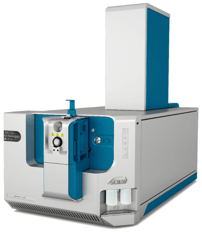
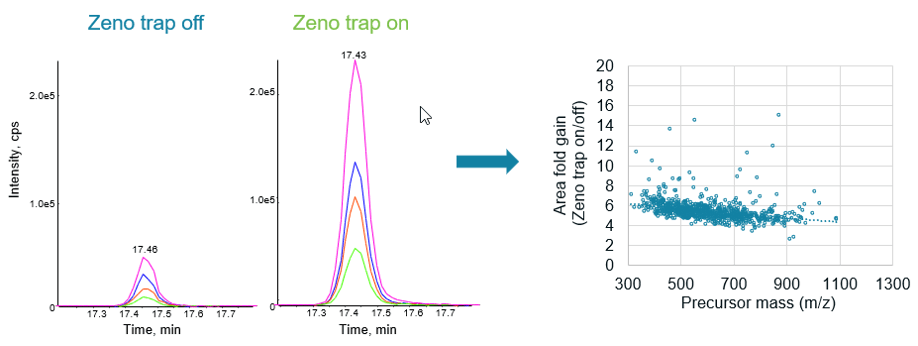 Click to enlarge
Click to enlarge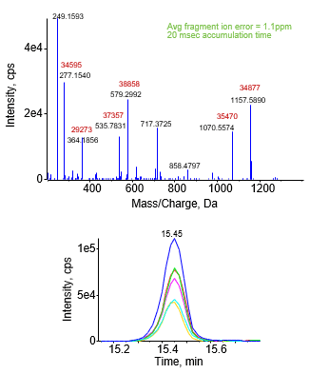 Click to enlarge
Click to enlarge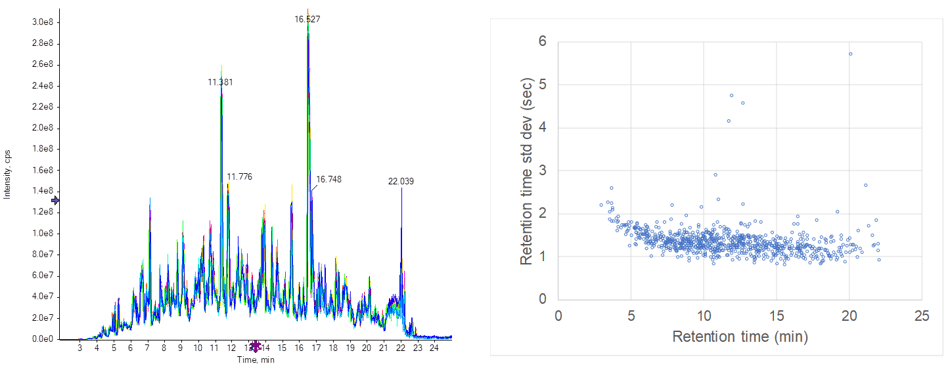 Click to enlarge
Click to enlarge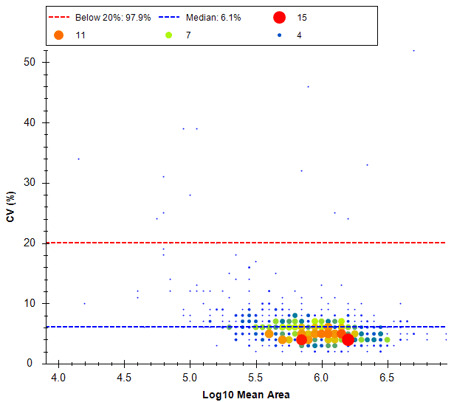 Click to enlarge
Click to enlarge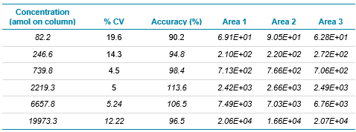 Click to enlarge
Click to enlarge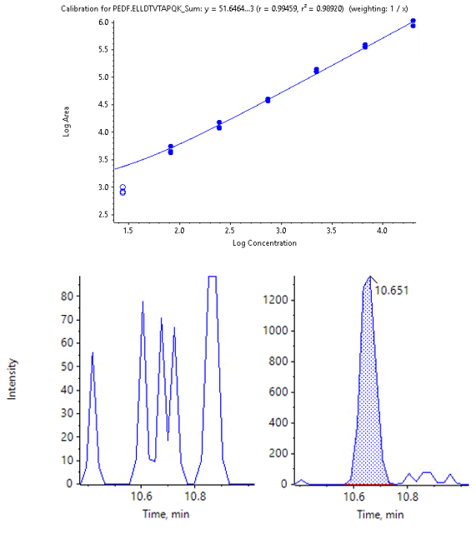 Click to enlarge
Click to enlarge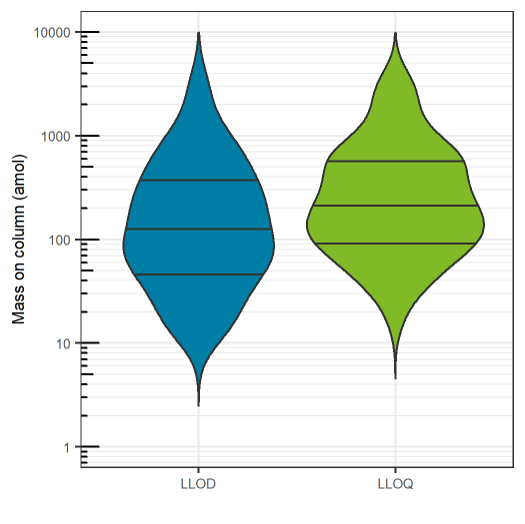 Click to enlarge
Click to enlarge